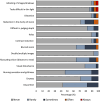Randomised clinical trial of extended depth of focus lenses for controlling myopia progression: Outcomes from SEED LVPEI Indian Myopia Study
- PMID: 38604622
- PMCID: PMC11347265
- DOI: 10.1136/bjo-2023-323651
Randomised clinical trial of extended depth of focus lenses for controlling myopia progression: Outcomes from SEED LVPEI Indian Myopia Study
Abstract
Purpose: To determine the efficacy of extended depth of focus (EDOF) contact lenses for controlling myopia progression in children through a 1-year randomised clinical trial.
Methods: A total of 104 children aged 7-15 years, with spherical equivalent refraction ≤-0.50 D, were randomly assigned to wear SEED 1 dayPure EDOF Mid contact lenses (n=48) or single vision spectacle lenses (n=56). Cycloplegic refraction with Shin-Nippon open field autorefractor and axial length with Lenstar LS 900 was determined at the baseline and 12-month visits. The compliance, visual discomfort and dryness questionnaires were administered during the final visit.
Results: Sixty-nine children (control: n=38; treatment: 31) completed the 12-month follow-up visit, with no difference in baseline characteristics between the groups. Mean (SEM) myopia progression in the 12th month was -0.48±0.07D in the control group and -0.20±0.08D in the treatment group. Mean axial elongation was 0.22±0.03 mm and 0.11±0.03 mm in the control and treatment groups, respectively. SEED 1 dayPure EDOF Mid contact lenses slowed myopia progression by 59% (-0.28D; p=0.01) based on spherical equivalent refraction and controlled axial length by 49% (0.11 mm; p=0.007) in comparison to single vision spectacle lenses. None of the participants reported any adverse effects. While most of the participants (82%) were comfortable with the contact lenses, 11% reported occasional dryness and 14% experienced mild fluctuations in visual acuity after immediate lens wear.
Conclusion: Daily wear of SEED 1 dayPure EDOF Mid contact lenses in Indian children showed a significant effect in controlling myopia progression and axial elongation.
Keywords: Clinical Trial; Contact lens; Vision.
© Author(s) (or their employer(s)) 2024. Re-use permitted under CC BY. Published by BMJ.
Conflict of interest statement
Competing interests: None declared.
Figures



Similar articles
-
MiSight Assessment Study Spain (MASS). A 2-year randomized clinical trial.Graefes Arch Clin Exp Ophthalmol. 2018 May;256(5):1011-1021. doi: 10.1007/s00417-018-3906-z. Epub 2018 Feb 3. Graefes Arch Clin Exp Ophthalmol. 2018. PMID: 29396662 Clinical Trial.
-
Axial Growth and Myopia Progression After Discontinuing Soft Multifocal Contact Lens Wear.JAMA Ophthalmol. 2025 Feb 1;143(2):155-162. doi: 10.1001/jamaophthalmol.2024.5885. JAMA Ophthalmol. 2025. PMID: 39821272 Clinical Trial.
-
The effect of individualized ocular refraction customized spectacle lenses on myopia control in schoolchildren: A 1-year randomised clinical trial.Ophthalmic Physiol Opt. 2024 Sep;44(6):1279-1289. doi: 10.1111/opo.13354. Epub 2024 Jun 27. Ophthalmic Physiol Opt. 2024. PMID: 38935437 Clinical Trial.
-
Interventions to slow progression of myopia in children.Cochrane Database Syst Rev. 2020 Jan 13;1(1):CD004916. doi: 10.1002/14651858.CD004916.pub4. Cochrane Database Syst Rev. 2020. PMID: 31930781 Free PMC article.
-
Multifocal Soft Contact Lenses for the Treatment of Myopia Progression in Children: A Report by the American Academy of Ophthalmology.Ophthalmology. 2025 Apr;132(4):495-503. doi: 10.1016/j.ophtha.2024.09.031. Epub 2024 Nov 7. Ophthalmology. 2025. PMID: 39503665 Review.
Cited by
-
Efficacy of a progressive multifocal soft contact lens in myopia management in Caucasian children: A two-year follow-up.J Optom. 2025 Jul-Sep;18(3):100567. doi: 10.1016/j.optom.2025.100567. Epub 2025 Jul 5. J Optom. 2025. PMID: 40618703 Free PMC article.
-
Axial Length Stabilization or Reduction in over 40% of Patients Wearing Extended Depth-of-Focus Contact Lenses.J Clin Med. 2025 Mar 5;14(5):1750. doi: 10.3390/jcm14051750. J Clin Med. 2025. PMID: 40095887 Free PMC article.
References
-
- Bakaraju RC, Ehrmann K, Papas EB, et al. Do peripheral refraction and aberration profiles vary with the type of mmyopia? - An illustration using a ray-tracing approach. J Optom 2009;2:29–38. 10.3921/joptom.2009.29 - DOI
Publication types
MeSH terms
LinkOut - more resources
Full Text Sources
